Google's Strategic International Business Management
VerifiedAdded on 2020/03/04
|16
|4131
|44
AI Summary
This assignment delves into the strategic international business management employed by Google. It examines key aspects of their global operations, including market entry strategies, competitive advantage, organizational structure, and cultural adaptation. The report aims to provide a thorough understanding of how Google has successfully navigated the complexities of international business.
Contribute Materials
Your contribution can guide someone’s learning journey. Share your
documents today.
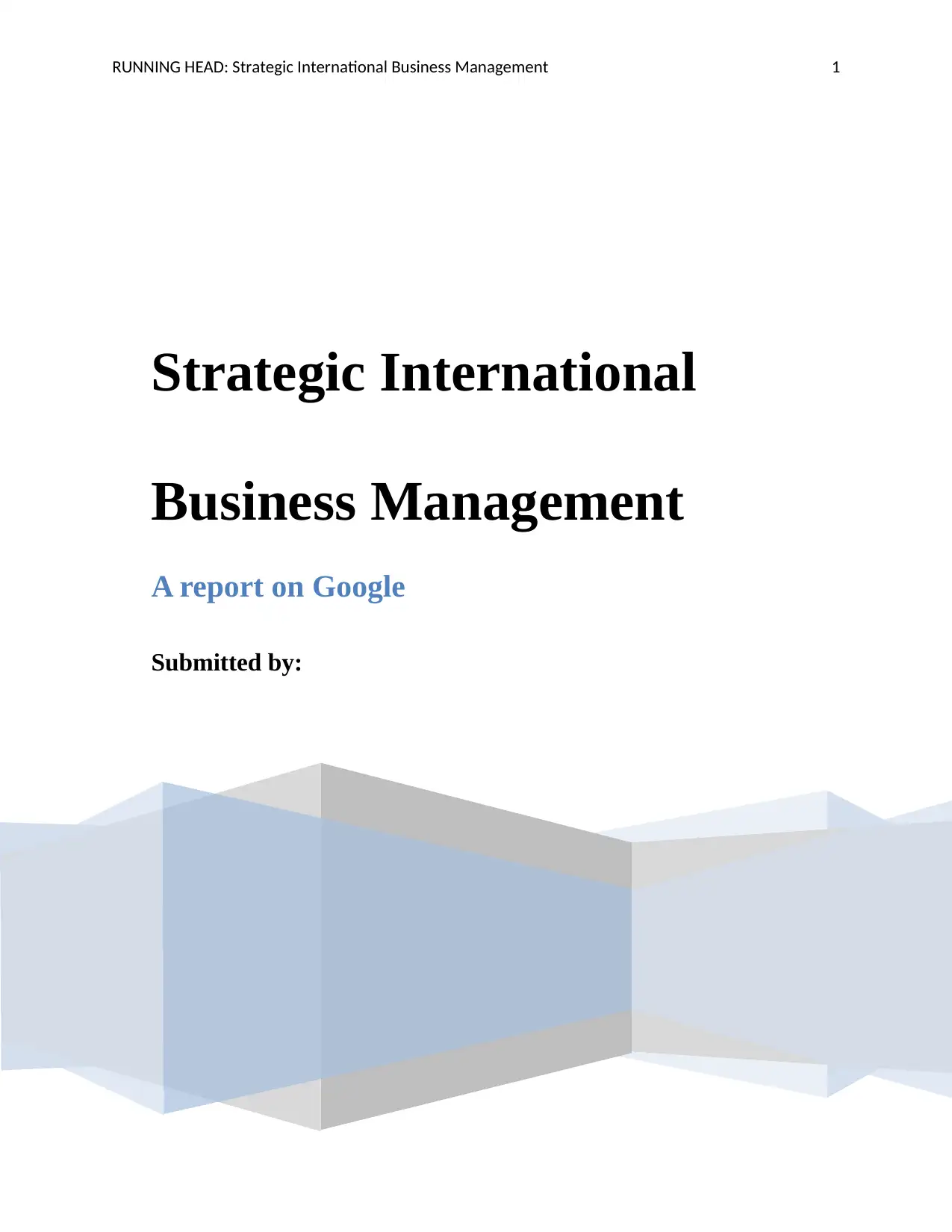
RUNNING HEAD: Strategic International Business Management 1
Strategic International
Business Management
A report on Google
Submitted by:
Strategic International
Business Management
A report on Google
Submitted by:
Secure Best Marks with AI Grader
Need help grading? Try our AI Grader for instant feedback on your assignments.
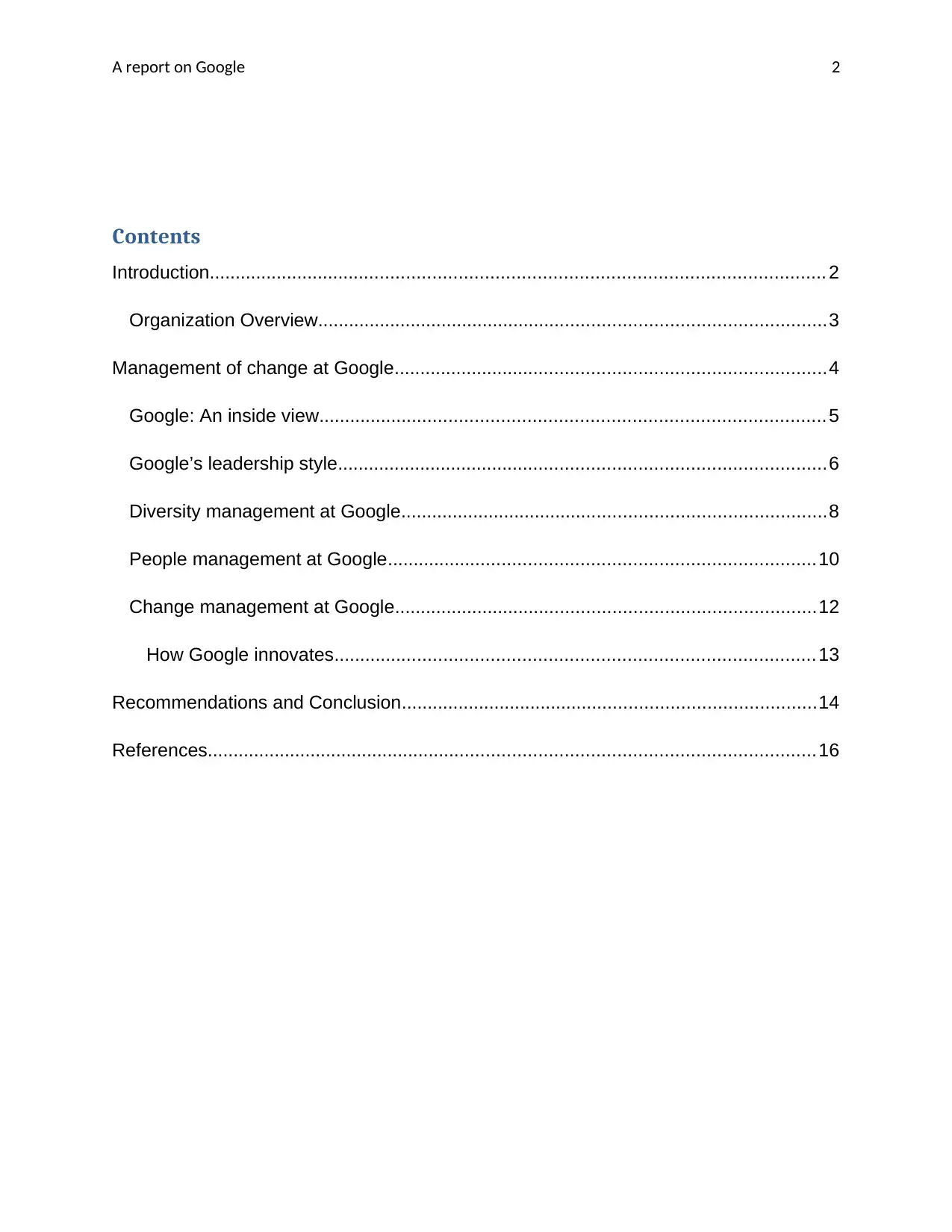
A report on Google 2
Contents
Introduction...................................................................................................................... 2
Organization Overview..................................................................................................3
Management of change at Google...................................................................................4
Google: An inside view................................................................................................. 5
Google’s leadership style..............................................................................................6
Diversity management at Google..................................................................................8
People management at Google..................................................................................10
Change management at Google.................................................................................12
How Google innovates............................................................................................ 13
Recommendations and Conclusion................................................................................14
References.....................................................................................................................16
Contents
Introduction...................................................................................................................... 2
Organization Overview..................................................................................................3
Management of change at Google...................................................................................4
Google: An inside view................................................................................................. 5
Google’s leadership style..............................................................................................6
Diversity management at Google..................................................................................8
People management at Google..................................................................................10
Change management at Google.................................................................................12
How Google innovates............................................................................................ 13
Recommendations and Conclusion................................................................................14
References.....................................................................................................................16
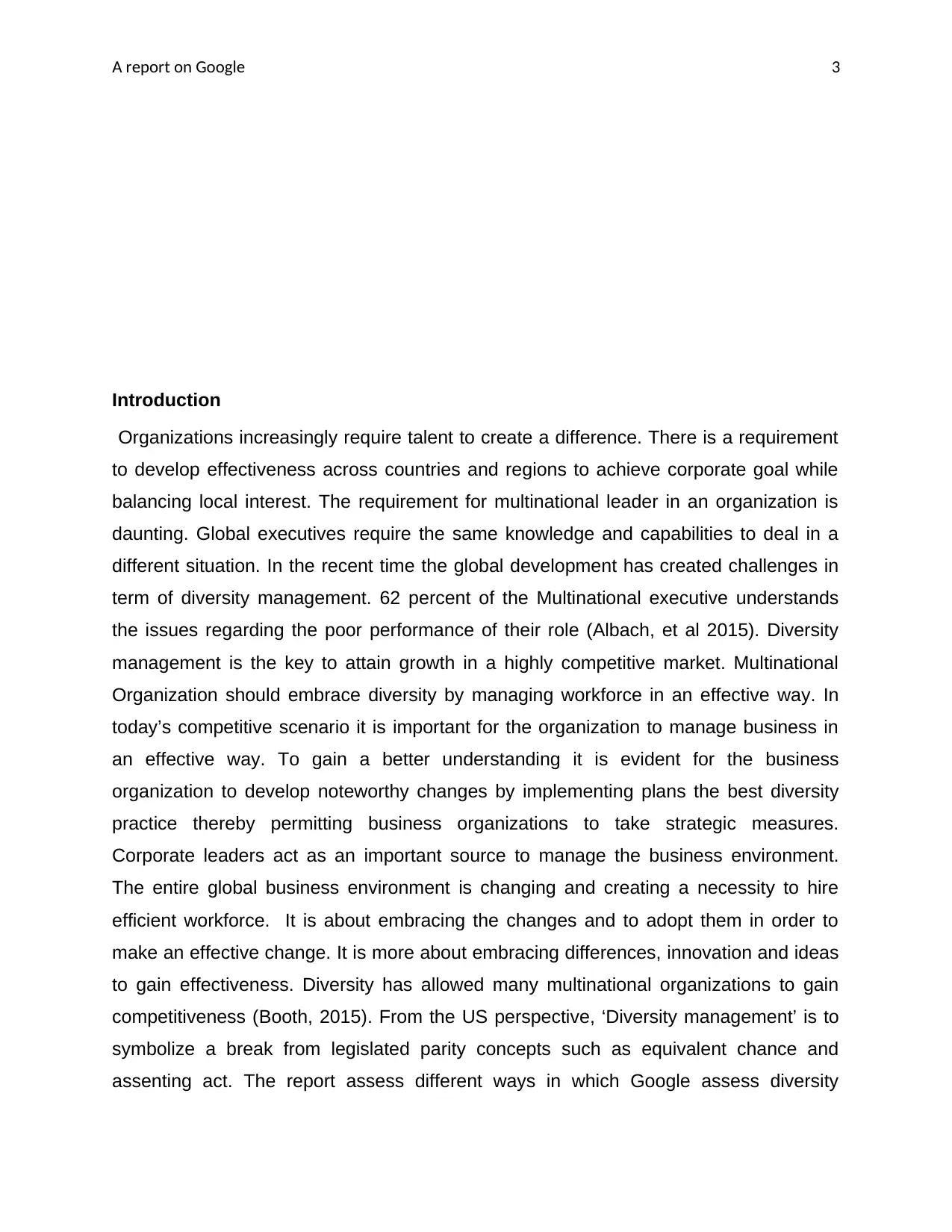
A report on Google 3
Introduction
Organizations increasingly require talent to create a difference. There is a requirement
to develop effectiveness across countries and regions to achieve corporate goal while
balancing local interest. The requirement for multinational leader in an organization is
daunting. Global executives require the same knowledge and capabilities to deal in a
different situation. In the recent time the global development has created challenges in
term of diversity management. 62 percent of the Multinational executive understands
the issues regarding the poor performance of their role (Albach, et al 2015). Diversity
management is the key to attain growth in a highly competitive market. Multinational
Organization should embrace diversity by managing workforce in an effective way. In
today’s competitive scenario it is important for the organization to manage business in
an effective way. To gain a better understanding it is evident for the business
organization to develop noteworthy changes by implementing plans the best diversity
practice thereby permitting business organizations to take strategic measures.
Corporate leaders act as an important source to manage the business environment.
The entire global business environment is changing and creating a necessity to hire
efficient workforce. It is about embracing the changes and to adopt them in order to
make an effective change. It is more about embracing differences, innovation and ideas
to gain effectiveness. Diversity has allowed many multinational organizations to gain
competitiveness (Booth, 2015). From the US perspective, ‘Diversity management’ is to
symbolize a break from legislated parity concepts such as equivalent chance and
assenting act. The report assess different ways in which Google assess diversity
Introduction
Organizations increasingly require talent to create a difference. There is a requirement
to develop effectiveness across countries and regions to achieve corporate goal while
balancing local interest. The requirement for multinational leader in an organization is
daunting. Global executives require the same knowledge and capabilities to deal in a
different situation. In the recent time the global development has created challenges in
term of diversity management. 62 percent of the Multinational executive understands
the issues regarding the poor performance of their role (Albach, et al 2015). Diversity
management is the key to attain growth in a highly competitive market. Multinational
Organization should embrace diversity by managing workforce in an effective way. In
today’s competitive scenario it is important for the organization to manage business in
an effective way. To gain a better understanding it is evident for the business
organization to develop noteworthy changes by implementing plans the best diversity
practice thereby permitting business organizations to take strategic measures.
Corporate leaders act as an important source to manage the business environment.
The entire global business environment is changing and creating a necessity to hire
efficient workforce. It is about embracing the changes and to adopt them in order to
make an effective change. It is more about embracing differences, innovation and ideas
to gain effectiveness. Diversity has allowed many multinational organizations to gain
competitiveness (Booth, 2015). From the US perspective, ‘Diversity management’ is to
symbolize a break from legislated parity concepts such as equivalent chance and
assenting act. The report assess different ways in which Google assess diversity
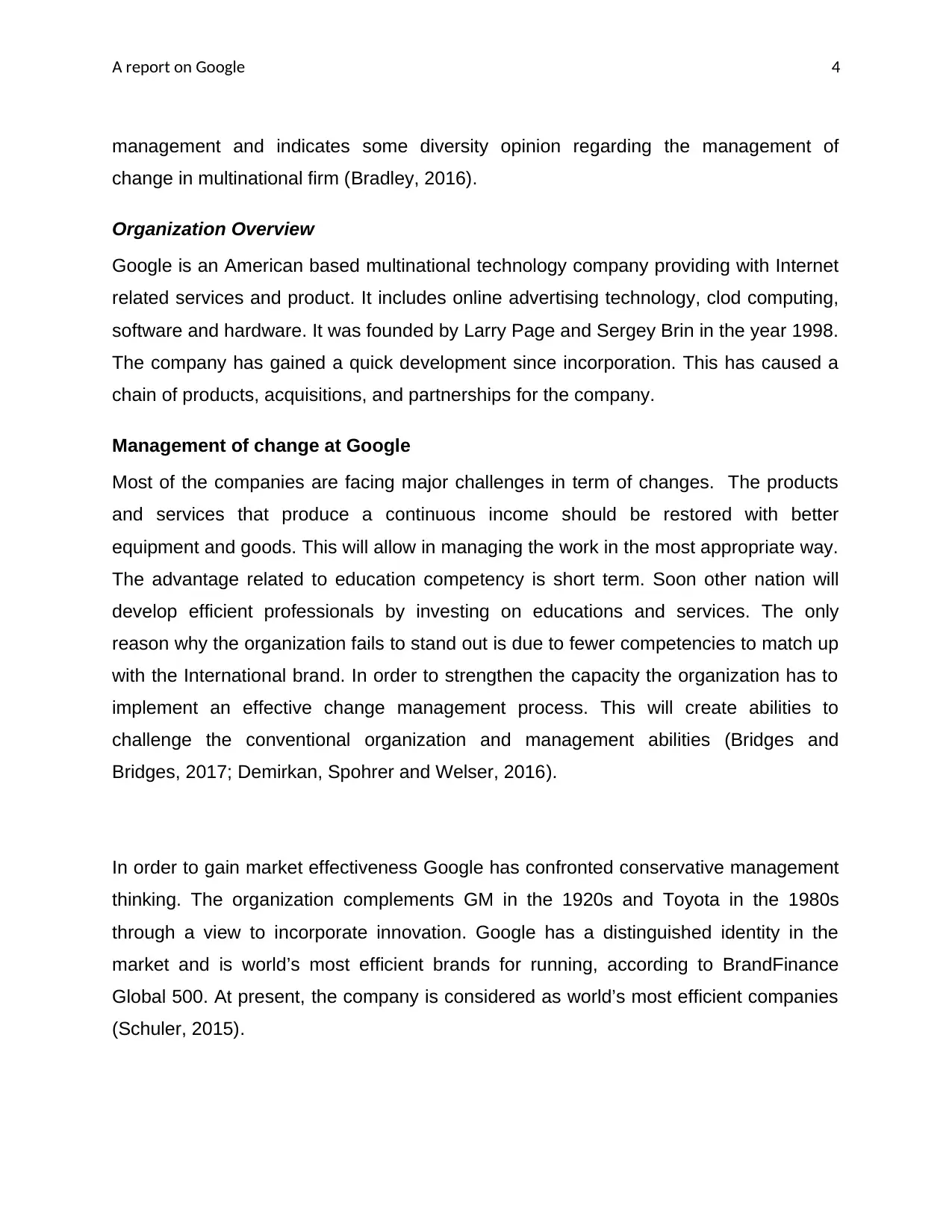
A report on Google 4
management and indicates some diversity opinion regarding the management of
change in multinational firm (Bradley, 2016).
Organization Overview
Google is an American based multinational technology company providing with Internet
related services and product. It includes online advertising technology, clod computing,
software and hardware. It was founded by Larry Page and Sergey Brin in the year 1998.
The company has gained a quick development since incorporation. This has caused a
chain of products, acquisitions, and partnerships for the company.
Management of change at Google
Most of the companies are facing major challenges in term of changes. The products
and services that produce a continuous income should be restored with better
equipment and goods. This will allow in managing the work in the most appropriate way.
The advantage related to education competency is short term. Soon other nation will
develop efficient professionals by investing on educations and services. The only
reason why the organization fails to stand out is due to fewer competencies to match up
with the International brand. In order to strengthen the capacity the organization has to
implement an effective change management process. This will create abilities to
challenge the conventional organization and management abilities (Bridges and
Bridges, 2017; Demirkan, Spohrer and Welser, 2016).
In order to gain market effectiveness Google has confronted conservative management
thinking. The organization complements GM in the 1920s and Toyota in the 1980s
through a view to incorporate innovation. Google has a distinguished identity in the
market and is world’s most efficient brands for running, according to BrandFinance
Global 500. At present, the company is considered as world’s most efficient companies
(Schuler, 2015).
management and indicates some diversity opinion regarding the management of
change in multinational firm (Bradley, 2016).
Organization Overview
Google is an American based multinational technology company providing with Internet
related services and product. It includes online advertising technology, clod computing,
software and hardware. It was founded by Larry Page and Sergey Brin in the year 1998.
The company has gained a quick development since incorporation. This has caused a
chain of products, acquisitions, and partnerships for the company.
Management of change at Google
Most of the companies are facing major challenges in term of changes. The products
and services that produce a continuous income should be restored with better
equipment and goods. This will allow in managing the work in the most appropriate way.
The advantage related to education competency is short term. Soon other nation will
develop efficient professionals by investing on educations and services. The only
reason why the organization fails to stand out is due to fewer competencies to match up
with the International brand. In order to strengthen the capacity the organization has to
implement an effective change management process. This will create abilities to
challenge the conventional organization and management abilities (Bridges and
Bridges, 2017; Demirkan, Spohrer and Welser, 2016).
In order to gain market effectiveness Google has confronted conservative management
thinking. The organization complements GM in the 1920s and Toyota in the 1980s
through a view to incorporate innovation. Google has a distinguished identity in the
market and is world’s most efficient brands for running, according to BrandFinance
Global 500. At present, the company is considered as world’s most efficient companies
(Schuler, 2015).
Secure Best Marks with AI Grader
Need help grading? Try our AI Grader for instant feedback on your assignments.
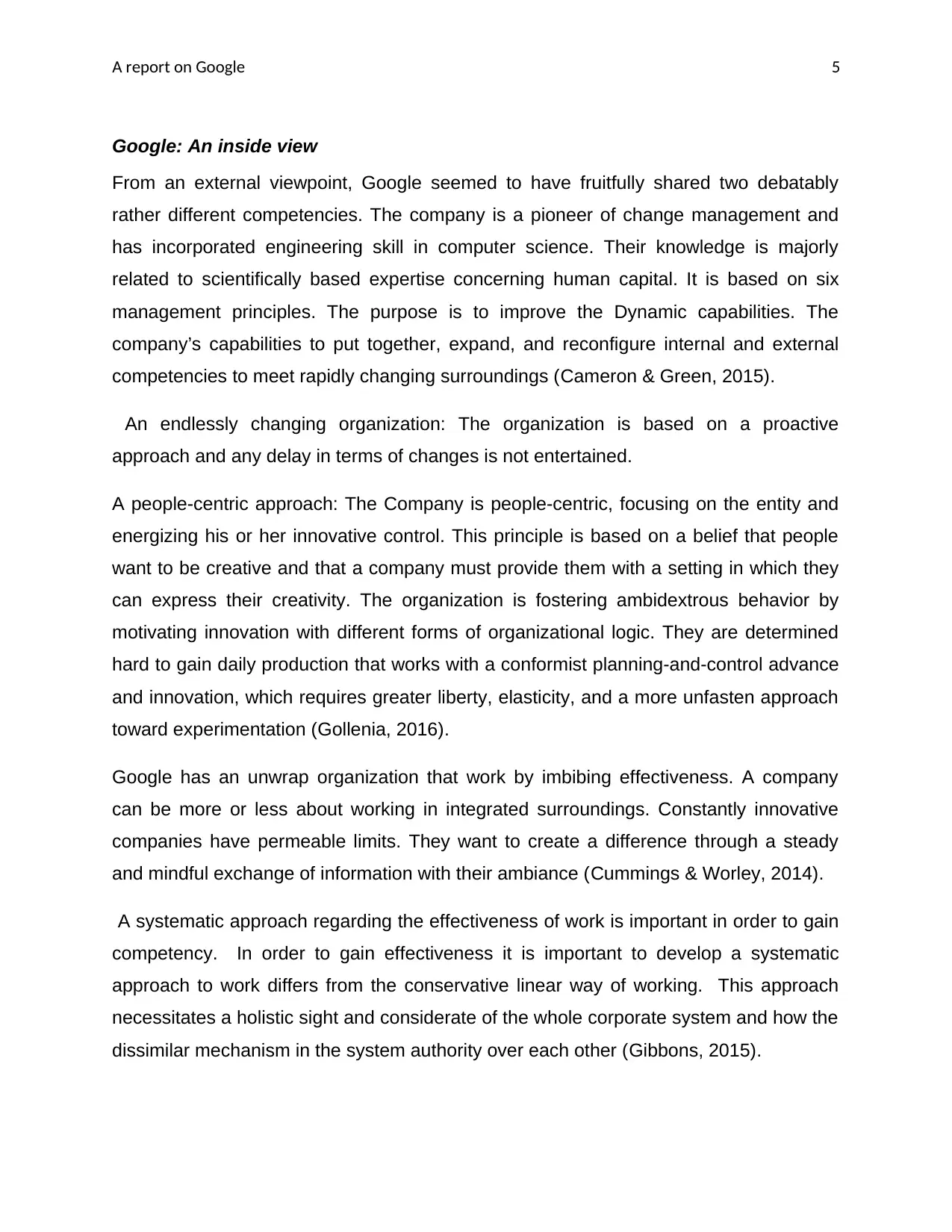
A report on Google 5
Google: An inside view
From an external viewpoint, Google seemed to have fruitfully shared two debatably
rather different competencies. The company is a pioneer of change management and
has incorporated engineering skill in computer science. Their knowledge is majorly
related to scientifically based expertise concerning human capital. It is based on six
management principles. The purpose is to improve the Dynamic capabilities. The
company’s capabilities to put together, expand, and reconfigure internal and external
competencies to meet rapidly changing surroundings (Cameron & Green, 2015).
An endlessly changing organization: The organization is based on a proactive
approach and any delay in terms of changes is not entertained.
A people-centric approach: The Company is people-centric, focusing on the entity and
energizing his or her innovative control. This principle is based on a belief that people
want to be creative and that a company must provide them with a setting in which they
can express their creativity. The organization is fostering ambidextrous behavior by
motivating innovation with different forms of organizational logic. They are determined
hard to gain daily production that works with a conformist planning-and-control advance
and innovation, which requires greater liberty, elasticity, and a more unfasten approach
toward experimentation (Gollenia, 2016).
Google has an unwrap organization that work by imbibing effectiveness. A company
can be more or less about working in integrated surroundings. Constantly innovative
companies have permeable limits. They want to create a difference through a steady
and mindful exchange of information with their ambiance (Cummings & Worley, 2014).
A systematic approach regarding the effectiveness of work is important in order to gain
competency. In order to gain effectiveness it is important to develop a systematic
approach to work differs from the conservative linear way of working. This approach
necessitates a holistic sight and considerate of the whole corporate system and how the
dissimilar mechanism in the system authority over each other (Gibbons, 2015).
Google: An inside view
From an external viewpoint, Google seemed to have fruitfully shared two debatably
rather different competencies. The company is a pioneer of change management and
has incorporated engineering skill in computer science. Their knowledge is majorly
related to scientifically based expertise concerning human capital. It is based on six
management principles. The purpose is to improve the Dynamic capabilities. The
company’s capabilities to put together, expand, and reconfigure internal and external
competencies to meet rapidly changing surroundings (Cameron & Green, 2015).
An endlessly changing organization: The organization is based on a proactive
approach and any delay in terms of changes is not entertained.
A people-centric approach: The Company is people-centric, focusing on the entity and
energizing his or her innovative control. This principle is based on a belief that people
want to be creative and that a company must provide them with a setting in which they
can express their creativity. The organization is fostering ambidextrous behavior by
motivating innovation with different forms of organizational logic. They are determined
hard to gain daily production that works with a conformist planning-and-control advance
and innovation, which requires greater liberty, elasticity, and a more unfasten approach
toward experimentation (Gollenia, 2016).
Google has an unwrap organization that work by imbibing effectiveness. A company
can be more or less about working in integrated surroundings. Constantly innovative
companies have permeable limits. They want to create a difference through a steady
and mindful exchange of information with their ambiance (Cummings & Worley, 2014).
A systematic approach regarding the effectiveness of work is important in order to gain
competency. In order to gain effectiveness it is important to develop a systematic
approach to work differs from the conservative linear way of working. This approach
necessitates a holistic sight and considerate of the whole corporate system and how the
dissimilar mechanism in the system authority over each other (Gibbons, 2015).
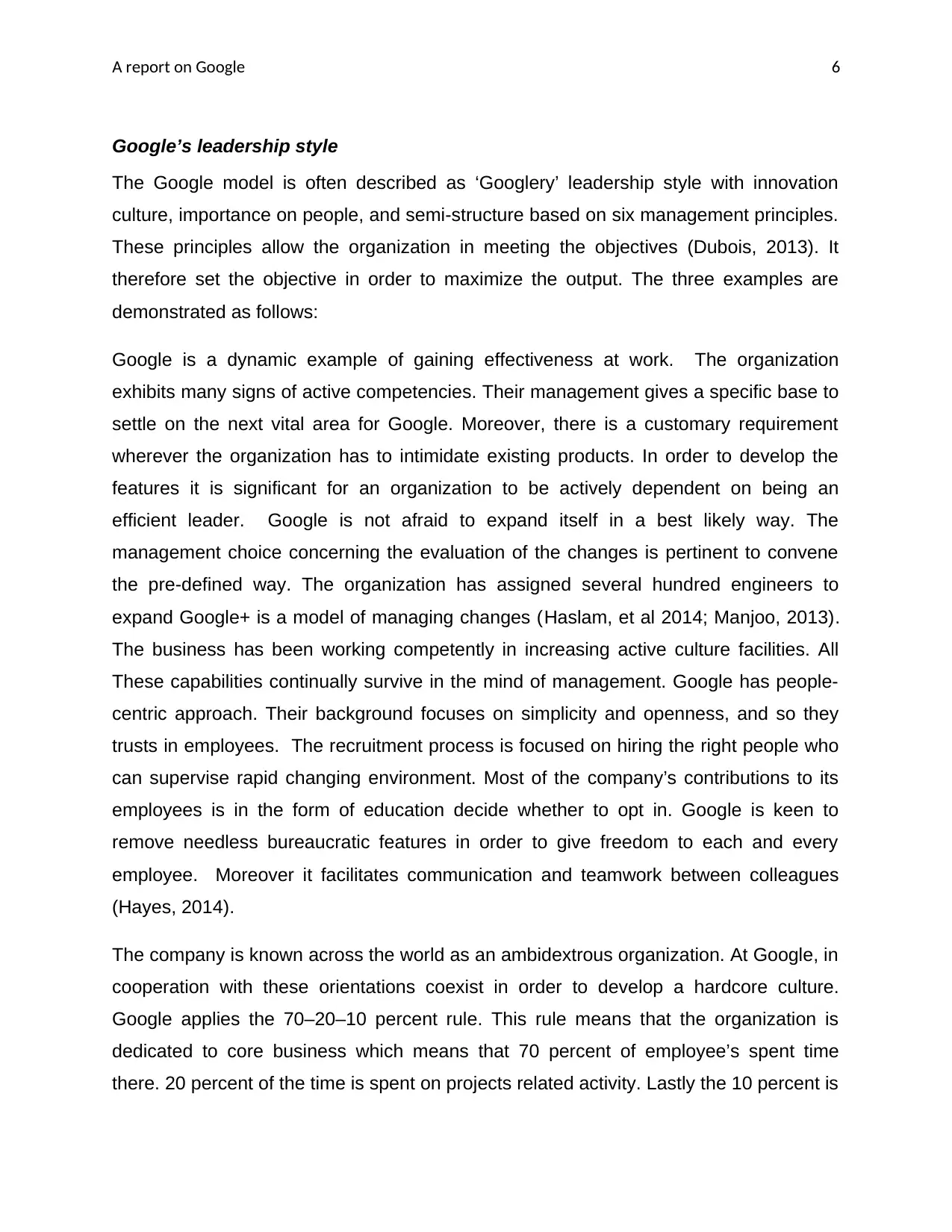
A report on Google 6
Google’s leadership style
The Google model is often described as ‘Googlery’ leadership style with innovation
culture, importance on people, and semi-structure based on six management principles.
These principles allow the organization in meeting the objectives (Dubois, 2013). It
therefore set the objective in order to maximize the output. The three examples are
demonstrated as follows:
Google is a dynamic example of gaining effectiveness at work. The organization
exhibits many signs of active competencies. Their management gives a specific base to
settle on the next vital area for Google. Moreover, there is a customary requirement
wherever the organization has to intimidate existing products. In order to develop the
features it is significant for an organization to be actively dependent on being an
efficient leader. Google is not afraid to expand itself in a best likely way. The
management choice concerning the evaluation of the changes is pertinent to convene
the pre-defined way. The organization has assigned several hundred engineers to
expand Google+ is a model of managing changes (Haslam, et al 2014; Manjoo, 2013).
The business has been working competently in increasing active culture facilities. All
These capabilities continually survive in the mind of management. Google has people-
centric approach. Their background focuses on simplicity and openness, and so they
trusts in employees. The recruitment process is focused on hiring the right people who
can supervise rapid changing environment. Most of the company’s contributions to its
employees is in the form of education decide whether to opt in. Google is keen to
remove needless bureaucratic features in order to give freedom to each and every
employee. Moreover it facilitates communication and teamwork between colleagues
(Hayes, 2014).
The company is known across the world as an ambidextrous organization. At Google, in
cooperation with these orientations coexist in order to develop a hardcore culture.
Google applies the 70–20–10 percent rule. This rule means that the organization is
dedicated to core business which means that 70 percent of employee’s spent time
there. 20 percent of the time is spent on projects related activity. Lastly the 10 percent is
Google’s leadership style
The Google model is often described as ‘Googlery’ leadership style with innovation
culture, importance on people, and semi-structure based on six management principles.
These principles allow the organization in meeting the objectives (Dubois, 2013). It
therefore set the objective in order to maximize the output. The three examples are
demonstrated as follows:
Google is a dynamic example of gaining effectiveness at work. The organization
exhibits many signs of active competencies. Their management gives a specific base to
settle on the next vital area for Google. Moreover, there is a customary requirement
wherever the organization has to intimidate existing products. In order to develop the
features it is significant for an organization to be actively dependent on being an
efficient leader. Google is not afraid to expand itself in a best likely way. The
management choice concerning the evaluation of the changes is pertinent to convene
the pre-defined way. The organization has assigned several hundred engineers to
expand Google+ is a model of managing changes (Haslam, et al 2014; Manjoo, 2013).
The business has been working competently in increasing active culture facilities. All
These capabilities continually survive in the mind of management. Google has people-
centric approach. Their background focuses on simplicity and openness, and so they
trusts in employees. The recruitment process is focused on hiring the right people who
can supervise rapid changing environment. Most of the company’s contributions to its
employees is in the form of education decide whether to opt in. Google is keen to
remove needless bureaucratic features in order to give freedom to each and every
employee. Moreover it facilitates communication and teamwork between colleagues
(Hayes, 2014).
The company is known across the world as an ambidextrous organization. At Google, in
cooperation with these orientations coexist in order to develop a hardcore culture.
Google applies the 70–20–10 percent rule. This rule means that the organization is
dedicated to core business which means that 70 percent of employee’s spent time
there. 20 percent of the time is spent on projects related activity. Lastly the 10 percent is
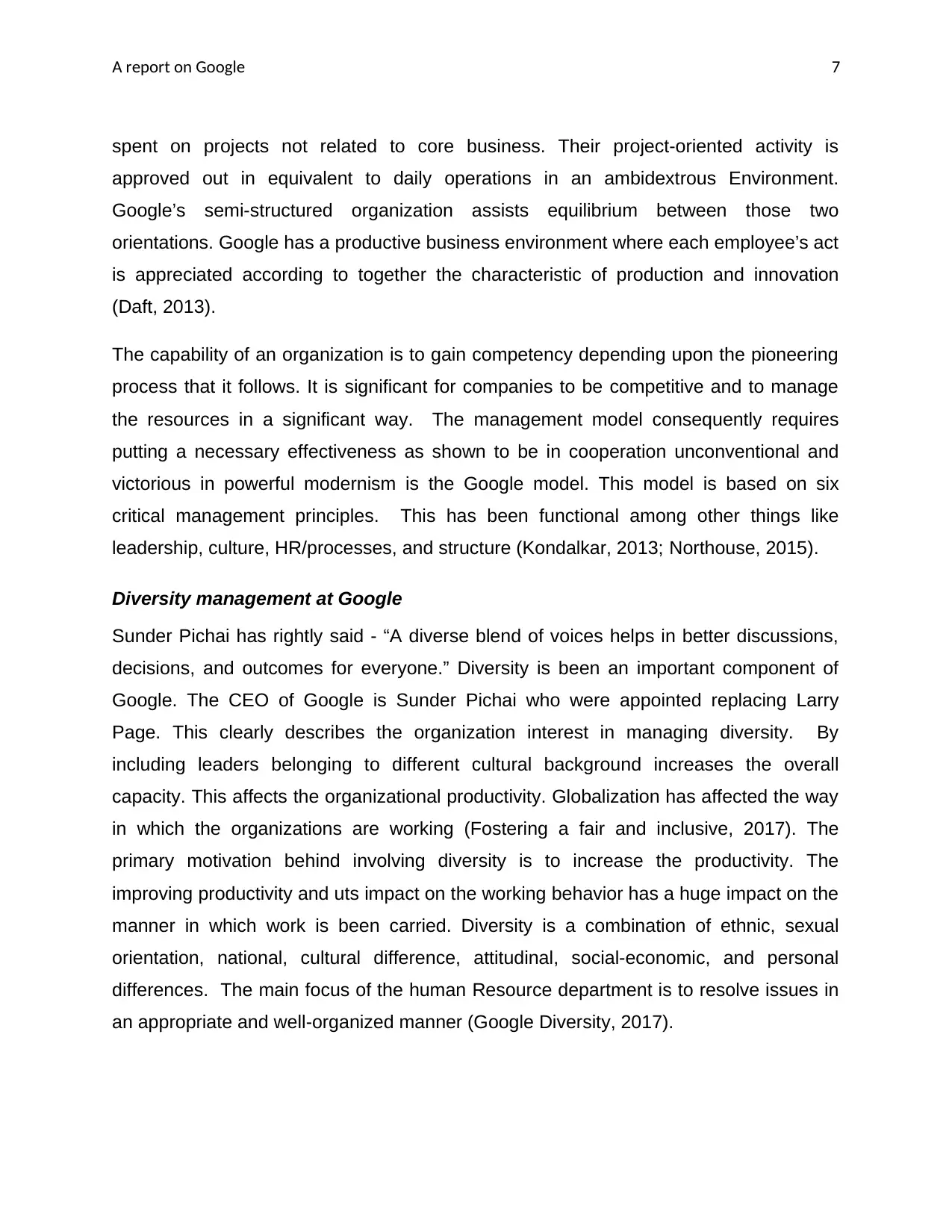
A report on Google 7
spent on projects not related to core business. Their project-oriented activity is
approved out in equivalent to daily operations in an ambidextrous Environment.
Google’s semi-structured organization assists equilibrium between those two
orientations. Google has a productive business environment where each employee’s act
is appreciated according to together the characteristic of production and innovation
(Daft, 2013).
The capability of an organization is to gain competency depending upon the pioneering
process that it follows. It is significant for companies to be competitive and to manage
the resources in a significant way. The management model consequently requires
putting a necessary effectiveness as shown to be in cooperation unconventional and
victorious in powerful modernism is the Google model. This model is based on six
critical management principles. This has been functional among other things like
leadership, culture, HR/processes, and structure (Kondalkar, 2013; Northouse, 2015).
Diversity management at Google
Sunder Pichai has rightly said - “A diverse blend of voices helps in better discussions,
decisions, and outcomes for everyone.” Diversity is been an important component of
Google. The CEO of Google is Sunder Pichai who were appointed replacing Larry
Page. This clearly describes the organization interest in managing diversity. By
including leaders belonging to different cultural background increases the overall
capacity. This affects the organizational productivity. Globalization has affected the way
in which the organizations are working (Fostering a fair and inclusive, 2017). The
primary motivation behind involving diversity is to increase the productivity. The
improving productivity and uts impact on the working behavior has a huge impact on the
manner in which work is been carried. Diversity is a combination of ethnic, sexual
orientation, national, cultural difference, attitudinal, social-economic, and personal
differences. The main focus of the human Resource department is to resolve issues in
an appropriate and well-organized manner (Google Diversity, 2017).
spent on projects not related to core business. Their project-oriented activity is
approved out in equivalent to daily operations in an ambidextrous Environment.
Google’s semi-structured organization assists equilibrium between those two
orientations. Google has a productive business environment where each employee’s act
is appreciated according to together the characteristic of production and innovation
(Daft, 2013).
The capability of an organization is to gain competency depending upon the pioneering
process that it follows. It is significant for companies to be competitive and to manage
the resources in a significant way. The management model consequently requires
putting a necessary effectiveness as shown to be in cooperation unconventional and
victorious in powerful modernism is the Google model. This model is based on six
critical management principles. This has been functional among other things like
leadership, culture, HR/processes, and structure (Kondalkar, 2013; Northouse, 2015).
Diversity management at Google
Sunder Pichai has rightly said - “A diverse blend of voices helps in better discussions,
decisions, and outcomes for everyone.” Diversity is been an important component of
Google. The CEO of Google is Sunder Pichai who were appointed replacing Larry
Page. This clearly describes the organization interest in managing diversity. By
including leaders belonging to different cultural background increases the overall
capacity. This affects the organizational productivity. Globalization has affected the way
in which the organizations are working (Fostering a fair and inclusive, 2017). The
primary motivation behind involving diversity is to increase the productivity. The
improving productivity and uts impact on the working behavior has a huge impact on the
manner in which work is been carried. Diversity is a combination of ethnic, sexual
orientation, national, cultural difference, attitudinal, social-economic, and personal
differences. The main focus of the human Resource department is to resolve issues in
an appropriate and well-organized manner (Google Diversity, 2017).
Paraphrase This Document
Need a fresh take? Get an instant paraphrase of this document with our AI Paraphraser
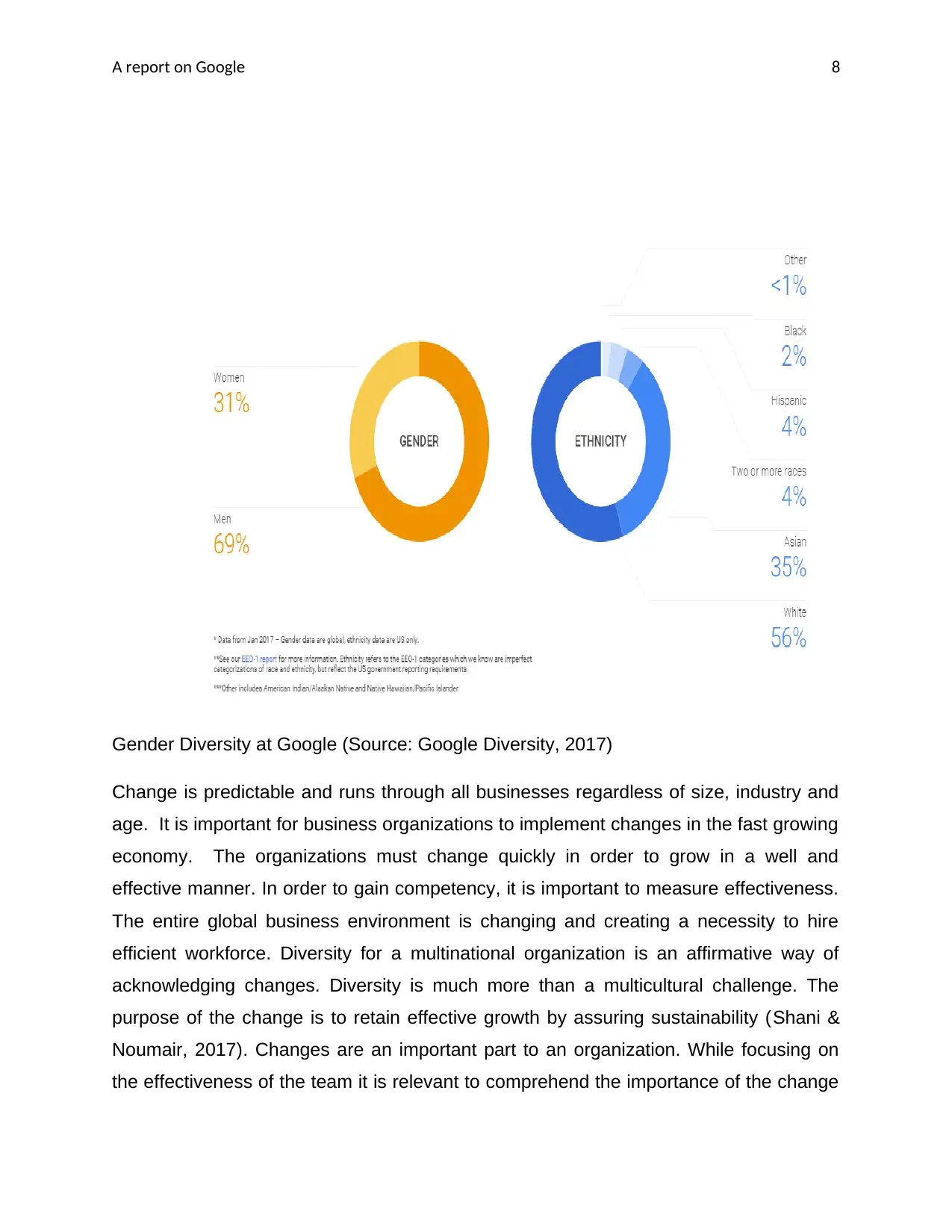
A report on Google 8
Gender Diversity at Google (Source: Google Diversity, 2017)
Change is predictable and runs through all businesses regardless of size, industry and
age. It is important for business organizations to implement changes in the fast growing
economy. The organizations must change quickly in order to grow in a well and
effective manner. In order to gain competency, it is important to measure effectiveness.
The entire global business environment is changing and creating a necessity to hire
efficient workforce. Diversity for a multinational organization is an affirmative way of
acknowledging changes. Diversity is much more than a multicultural challenge. The
purpose of the change is to retain effective growth by assuring sustainability (Shani &
Noumair, 2017). Changes are an important part to an organization. While focusing on
the effectiveness of the team it is relevant to comprehend the importance of the change
Gender Diversity at Google (Source: Google Diversity, 2017)
Change is predictable and runs through all businesses regardless of size, industry and
age. It is important for business organizations to implement changes in the fast growing
economy. The organizations must change quickly in order to grow in a well and
effective manner. In order to gain competency, it is important to measure effectiveness.
The entire global business environment is changing and creating a necessity to hire
efficient workforce. Diversity for a multinational organization is an affirmative way of
acknowledging changes. Diversity is much more than a multicultural challenge. The
purpose of the change is to retain effective growth by assuring sustainability (Shani &
Noumair, 2017). Changes are an important part to an organization. While focusing on
the effectiveness of the team it is relevant to comprehend the importance of the change
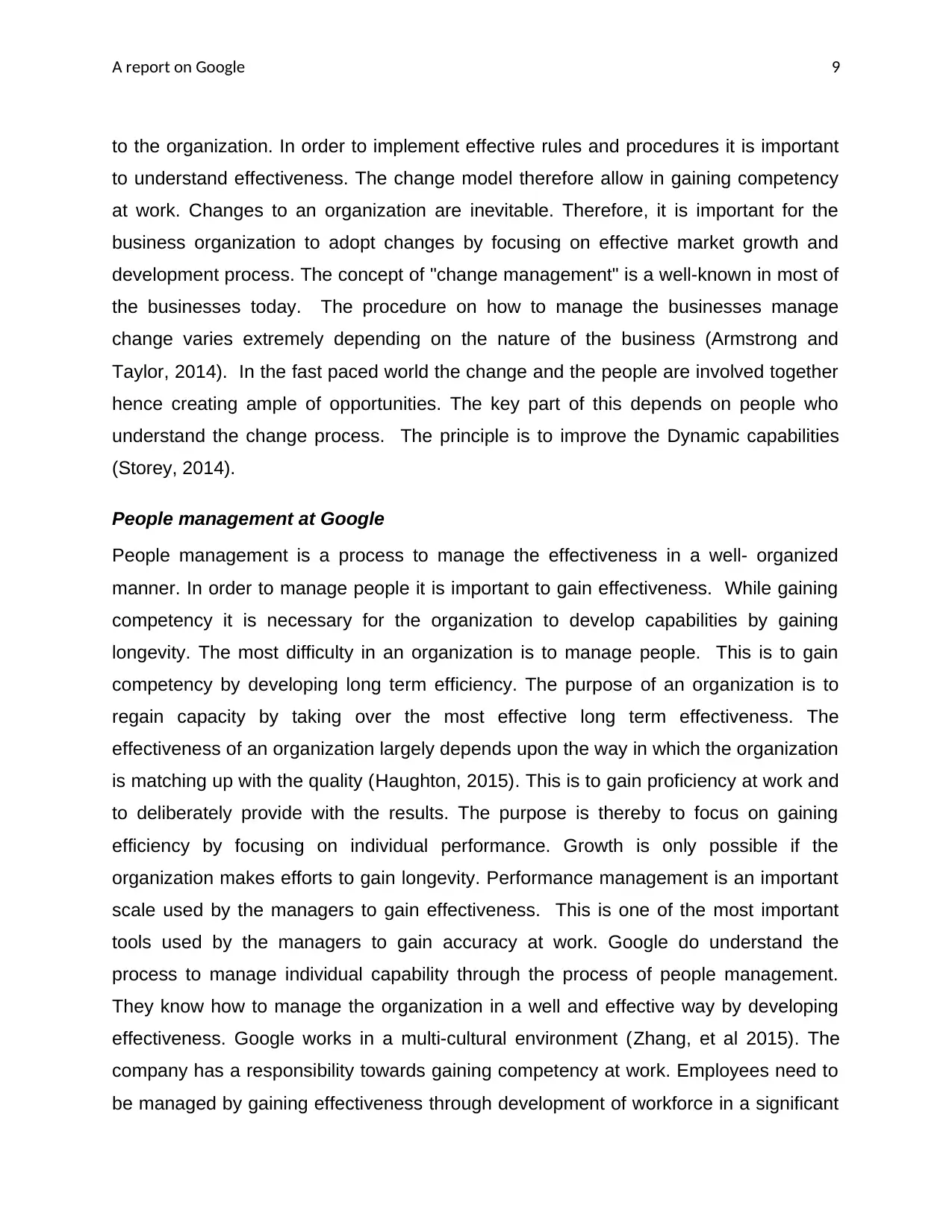
A report on Google 9
to the organization. In order to implement effective rules and procedures it is important
to understand effectiveness. The change model therefore allow in gaining competency
at work. Changes to an organization are inevitable. Therefore, it is important for the
business organization to adopt changes by focusing on effective market growth and
development process. The concept of "change management" is a well-known in most of
the businesses today. The procedure on how to manage the businesses manage
change varies extremely depending on the nature of the business (Armstrong and
Taylor, 2014). In the fast paced world the change and the people are involved together
hence creating ample of opportunities. The key part of this depends on people who
understand the change process. The principle is to improve the Dynamic capabilities
(Storey, 2014).
People management at Google
People management is a process to manage the effectiveness in a well- organized
manner. In order to manage people it is important to gain effectiveness. While gaining
competency it is necessary for the organization to develop capabilities by gaining
longevity. The most difficulty in an organization is to manage people. This is to gain
competency by developing long term efficiency. The purpose of an organization is to
regain capacity by taking over the most effective long term effectiveness. The
effectiveness of an organization largely depends upon the way in which the organization
is matching up with the quality (Haughton, 2015). This is to gain proficiency at work and
to deliberately provide with the results. The purpose is thereby to focus on gaining
efficiency by focusing on individual performance. Growth is only possible if the
organization makes efforts to gain longevity. Performance management is an important
scale used by the managers to gain effectiveness. This is one of the most important
tools used by the managers to gain accuracy at work. Google do understand the
process to manage individual capability through the process of people management.
They know how to manage the organization in a well and effective way by developing
effectiveness. Google works in a multi-cultural environment (Zhang, et al 2015). The
company has a responsibility towards gaining competency at work. Employees need to
be managed by gaining effectiveness through development of workforce in a significant
to the organization. In order to implement effective rules and procedures it is important
to understand effectiveness. The change model therefore allow in gaining competency
at work. Changes to an organization are inevitable. Therefore, it is important for the
business organization to adopt changes by focusing on effective market growth and
development process. The concept of "change management" is a well-known in most of
the businesses today. The procedure on how to manage the businesses manage
change varies extremely depending on the nature of the business (Armstrong and
Taylor, 2014). In the fast paced world the change and the people are involved together
hence creating ample of opportunities. The key part of this depends on people who
understand the change process. The principle is to improve the Dynamic capabilities
(Storey, 2014).
People management at Google
People management is a process to manage the effectiveness in a well- organized
manner. In order to manage people it is important to gain effectiveness. While gaining
competency it is necessary for the organization to develop capabilities by gaining
longevity. The most difficulty in an organization is to manage people. This is to gain
competency by developing long term efficiency. The purpose of an organization is to
regain capacity by taking over the most effective long term effectiveness. The
effectiveness of an organization largely depends upon the way in which the organization
is matching up with the quality (Haughton, 2015). This is to gain proficiency at work and
to deliberately provide with the results. The purpose is thereby to focus on gaining
efficiency by focusing on individual performance. Growth is only possible if the
organization makes efforts to gain longevity. Performance management is an important
scale used by the managers to gain effectiveness. This is one of the most important
tools used by the managers to gain accuracy at work. Google do understand the
process to manage individual capability through the process of people management.
They know how to manage the organization in a well and effective way by developing
effectiveness. Google works in a multi-cultural environment (Zhang, et al 2015). The
company has a responsibility towards gaining competency at work. Employees need to
be managed by gaining effectiveness through development of workforce in a significant
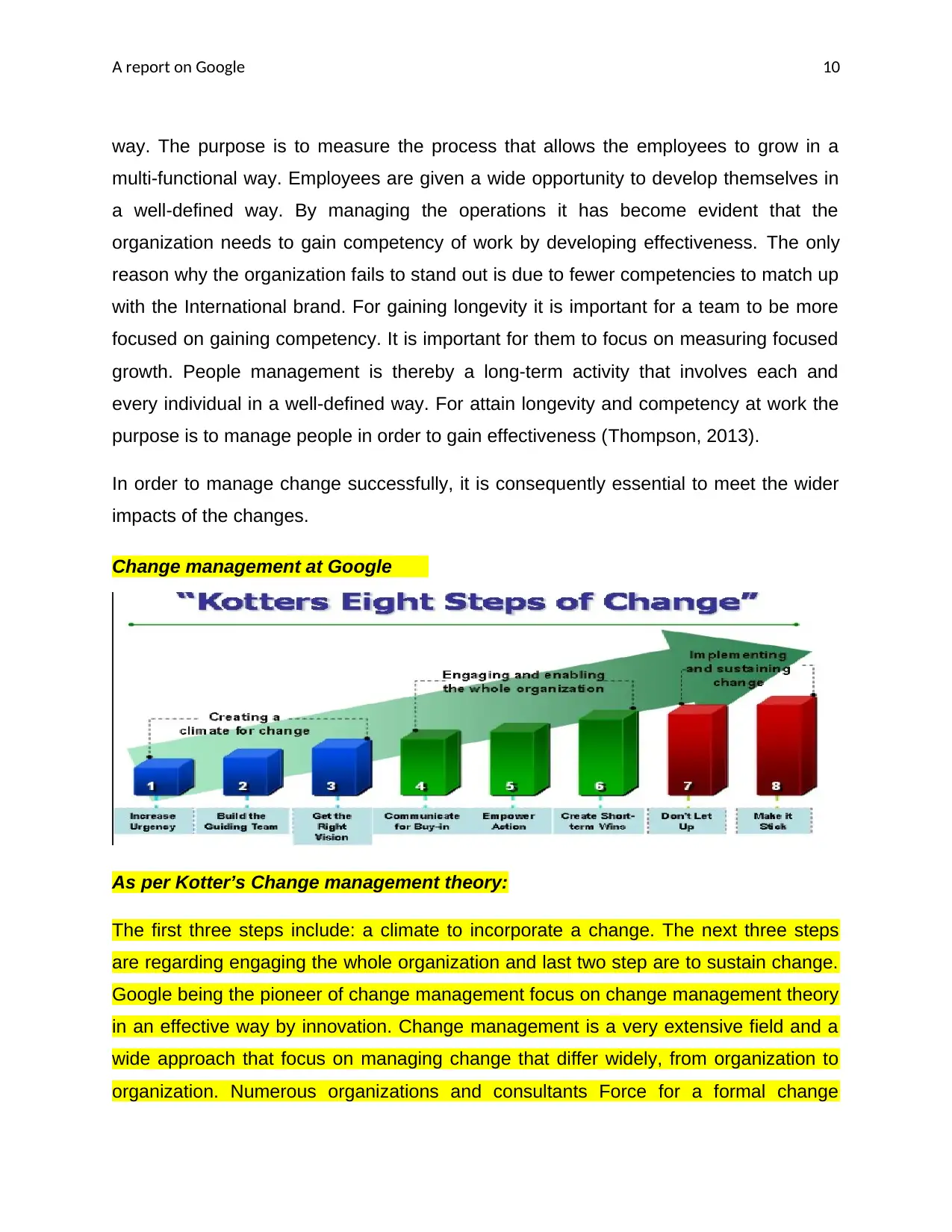
A report on Google 10
way. The purpose is to measure the process that allows the employees to grow in a
multi-functional way. Employees are given a wide opportunity to develop themselves in
a well-defined way. By managing the operations it has become evident that the
organization needs to gain competency of work by developing effectiveness. The only
reason why the organization fails to stand out is due to fewer competencies to match up
with the International brand. For gaining longevity it is important for a team to be more
focused on gaining competency. It is important for them to focus on measuring focused
growth. People management is thereby a long-term activity that involves each and
every individual in a well-defined way. For attain longevity and competency at work the
purpose is to manage people in order to gain effectiveness (Thompson, 2013).
In order to manage change successfully, it is consequently essential to meet the wider
impacts of the changes.
Change management at Google
As per Kotter’s Change management theory:
The first three steps include: a climate to incorporate a change. The next three steps
are regarding engaging the whole organization and last two step are to sustain change.
Google being the pioneer of change management focus on change management theory
in an effective way by innovation. Change management is a very extensive field and a
wide approach that focus on managing change that differ widely, from organization to
organization. Numerous organizations and consultants Force for a formal change
way. The purpose is to measure the process that allows the employees to grow in a
multi-functional way. Employees are given a wide opportunity to develop themselves in
a well-defined way. By managing the operations it has become evident that the
organization needs to gain competency of work by developing effectiveness. The only
reason why the organization fails to stand out is due to fewer competencies to match up
with the International brand. For gaining longevity it is important for a team to be more
focused on gaining competency. It is important for them to focus on measuring focused
growth. People management is thereby a long-term activity that involves each and
every individual in a well-defined way. For attain longevity and competency at work the
purpose is to manage people in order to gain effectiveness (Thompson, 2013).
In order to manage change successfully, it is consequently essential to meet the wider
impacts of the changes.
Change management at Google
As per Kotter’s Change management theory:
The first three steps include: a climate to incorporate a change. The next three steps
are regarding engaging the whole organization and last two step are to sustain change.
Google being the pioneer of change management focus on change management theory
in an effective way by innovation. Change management is a very extensive field and a
wide approach that focus on managing change that differ widely, from organization to
organization. Numerous organizations and consultants Force for a formal change
Secure Best Marks with AI Grader
Need help grading? Try our AI Grader for instant feedback on your assignments.
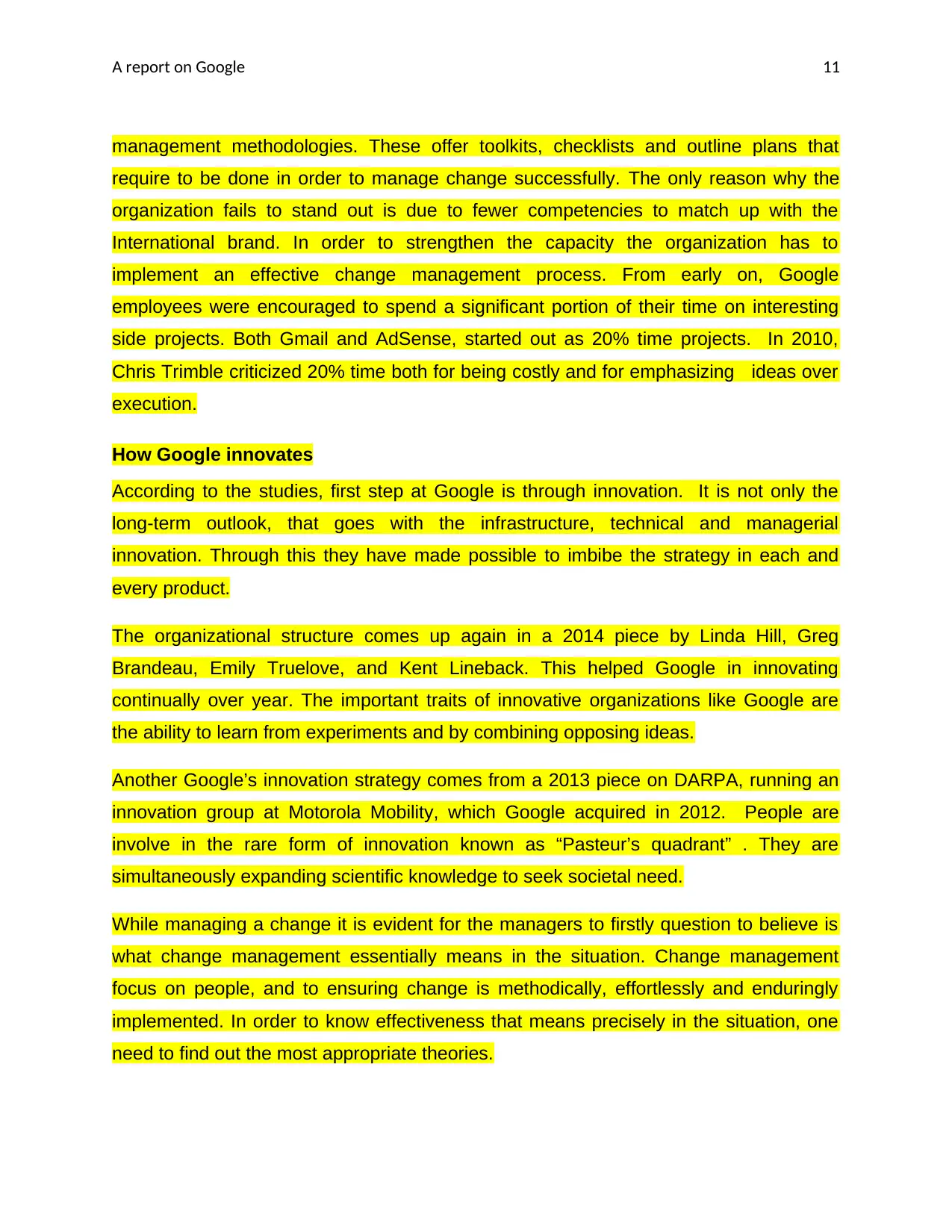
A report on Google 11
management methodologies. These offer toolkits, checklists and outline plans that
require to be done in order to manage change successfully. The only reason why the
organization fails to stand out is due to fewer competencies to match up with the
International brand. In order to strengthen the capacity the organization has to
implement an effective change management process. From early on, Google
employees were encouraged to spend a significant portion of their time on interesting
side projects. Both Gmail and AdSense, started out as 20% time projects. In 2010,
Chris Trimble criticized 20% time both for being costly and for emphasizing ideas over
execution.
How Google innovates
According to the studies, first step at Google is through innovation. It is not only the
long-term outlook, that goes with the infrastructure, technical and managerial
innovation. Through this they have made possible to imbibe the strategy in each and
every product.
The organizational structure comes up again in a 2014 piece by Linda Hill, Greg
Brandeau, Emily Truelove, and Kent Lineback. This helped Google in innovating
continually over year. The important traits of innovative organizations like Google are
the ability to learn from experiments and by combining opposing ideas.
Another Google’s innovation strategy comes from a 2013 piece on DARPA, running an
innovation group at Motorola Mobility, which Google acquired in 2012. People are
involve in the rare form of innovation known as “Pasteur’s quadrant” . They are
simultaneously expanding scientific knowledge to seek societal need.
While managing a change it is evident for the managers to firstly question to believe is
what change management essentially means in the situation. Change management
focus on people, and to ensuring change is methodically, effortlessly and enduringly
implemented. In order to know effectiveness that means precisely in the situation, one
need to find out the most appropriate theories.
management methodologies. These offer toolkits, checklists and outline plans that
require to be done in order to manage change successfully. The only reason why the
organization fails to stand out is due to fewer competencies to match up with the
International brand. In order to strengthen the capacity the organization has to
implement an effective change management process. From early on, Google
employees were encouraged to spend a significant portion of their time on interesting
side projects. Both Gmail and AdSense, started out as 20% time projects. In 2010,
Chris Trimble criticized 20% time both for being costly and for emphasizing ideas over
execution.
How Google innovates
According to the studies, first step at Google is through innovation. It is not only the
long-term outlook, that goes with the infrastructure, technical and managerial
innovation. Through this they have made possible to imbibe the strategy in each and
every product.
The organizational structure comes up again in a 2014 piece by Linda Hill, Greg
Brandeau, Emily Truelove, and Kent Lineback. This helped Google in innovating
continually over year. The important traits of innovative organizations like Google are
the ability to learn from experiments and by combining opposing ideas.
Another Google’s innovation strategy comes from a 2013 piece on DARPA, running an
innovation group at Motorola Mobility, which Google acquired in 2012. People are
involve in the rare form of innovation known as “Pasteur’s quadrant” . They are
simultaneously expanding scientific knowledge to seek societal need.
While managing a change it is evident for the managers to firstly question to believe is
what change management essentially means in the situation. Change management
focus on people, and to ensuring change is methodically, effortlessly and enduringly
implemented. In order to know effectiveness that means precisely in the situation, one
need to find out the most appropriate theories.
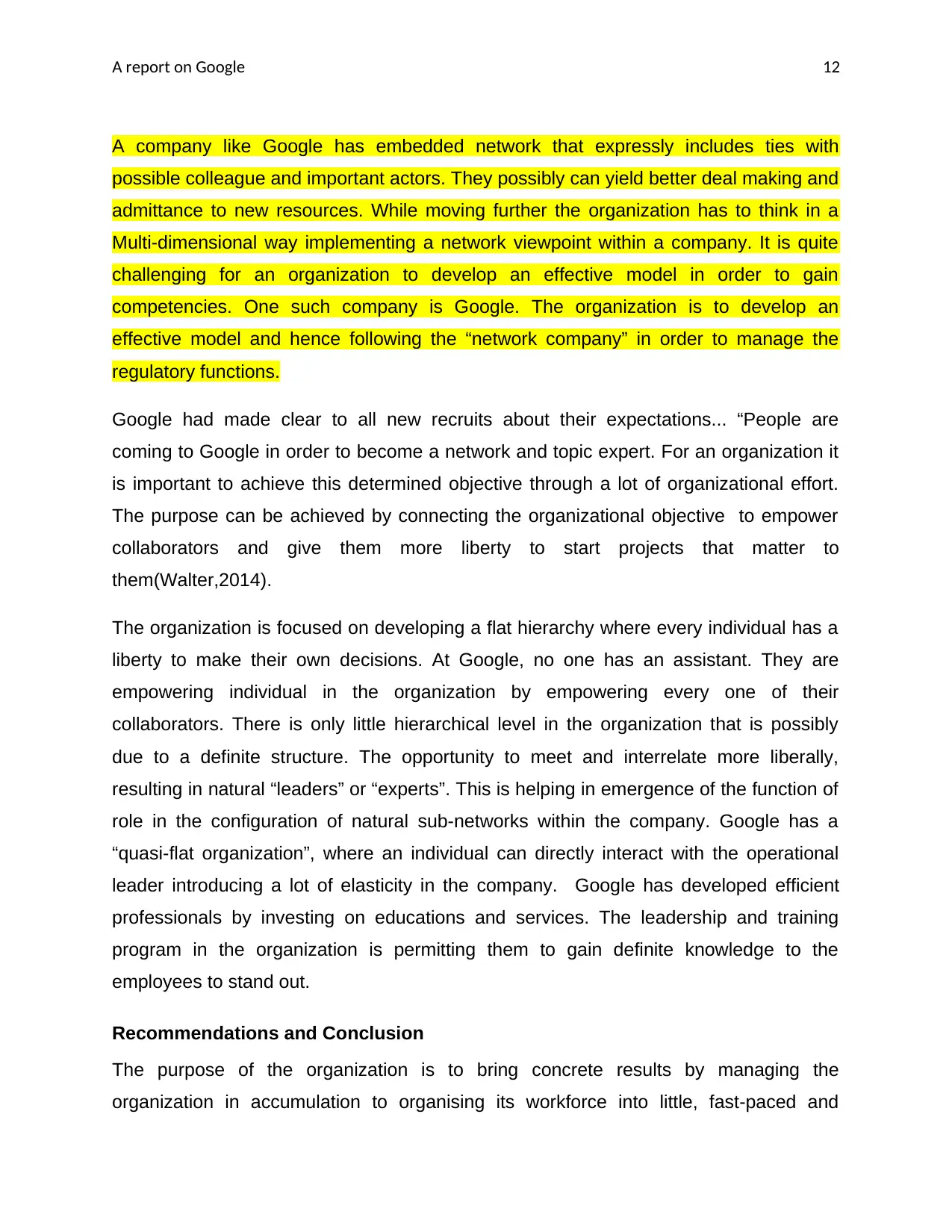
A report on Google 12
A company like Google has embedded network that expressly includes ties with
possible colleague and important actors. They possibly can yield better deal making and
admittance to new resources. While moving further the organization has to think in a
Multi-dimensional way implementing a network viewpoint within a company. It is quite
challenging for an organization to develop an effective model in order to gain
competencies. One such company is Google. The organization is to develop an
effective model and hence following the “network company” in order to manage the
regulatory functions.
Google had made clear to all new recruits about their expectations... “People are
coming to Google in order to become a network and topic expert. For an organization it
is important to achieve this determined objective through a lot of organizational effort.
The purpose can be achieved by connecting the organizational objective to empower
collaborators and give them more liberty to start projects that matter to
them(Walter,2014).
The organization is focused on developing a flat hierarchy where every individual has a
liberty to make their own decisions. At Google, no one has an assistant. They are
empowering individual in the organization by empowering every one of their
collaborators. There is only little hierarchical level in the organization that is possibly
due to a definite structure. The opportunity to meet and interrelate more liberally,
resulting in natural “leaders” or “experts”. This is helping in emergence of the function of
role in the configuration of natural sub-networks within the company. Google has a
“quasi-flat organization”, where an individual can directly interact with the operational
leader introducing a lot of elasticity in the company. Google has developed efficient
professionals by investing on educations and services. The leadership and training
program in the organization is permitting them to gain definite knowledge to the
employees to stand out.
Recommendations and Conclusion
The purpose of the organization is to bring concrete results by managing the
organization in accumulation to organising its workforce into little, fast-paced and
A company like Google has embedded network that expressly includes ties with
possible colleague and important actors. They possibly can yield better deal making and
admittance to new resources. While moving further the organization has to think in a
Multi-dimensional way implementing a network viewpoint within a company. It is quite
challenging for an organization to develop an effective model in order to gain
competencies. One such company is Google. The organization is to develop an
effective model and hence following the “network company” in order to manage the
regulatory functions.
Google had made clear to all new recruits about their expectations... “People are
coming to Google in order to become a network and topic expert. For an organization it
is important to achieve this determined objective through a lot of organizational effort.
The purpose can be achieved by connecting the organizational objective to empower
collaborators and give them more liberty to start projects that matter to
them(Walter,2014).
The organization is focused on developing a flat hierarchy where every individual has a
liberty to make their own decisions. At Google, no one has an assistant. They are
empowering individual in the organization by empowering every one of their
collaborators. There is only little hierarchical level in the organization that is possibly
due to a definite structure. The opportunity to meet and interrelate more liberally,
resulting in natural “leaders” or “experts”. This is helping in emergence of the function of
role in the configuration of natural sub-networks within the company. Google has a
“quasi-flat organization”, where an individual can directly interact with the operational
leader introducing a lot of elasticity in the company. Google has developed efficient
professionals by investing on educations and services. The leadership and training
program in the organization is permitting them to gain definite knowledge to the
employees to stand out.
Recommendations and Conclusion
The purpose of the organization is to bring concrete results by managing the
organization in accumulation to organising its workforce into little, fast-paced and
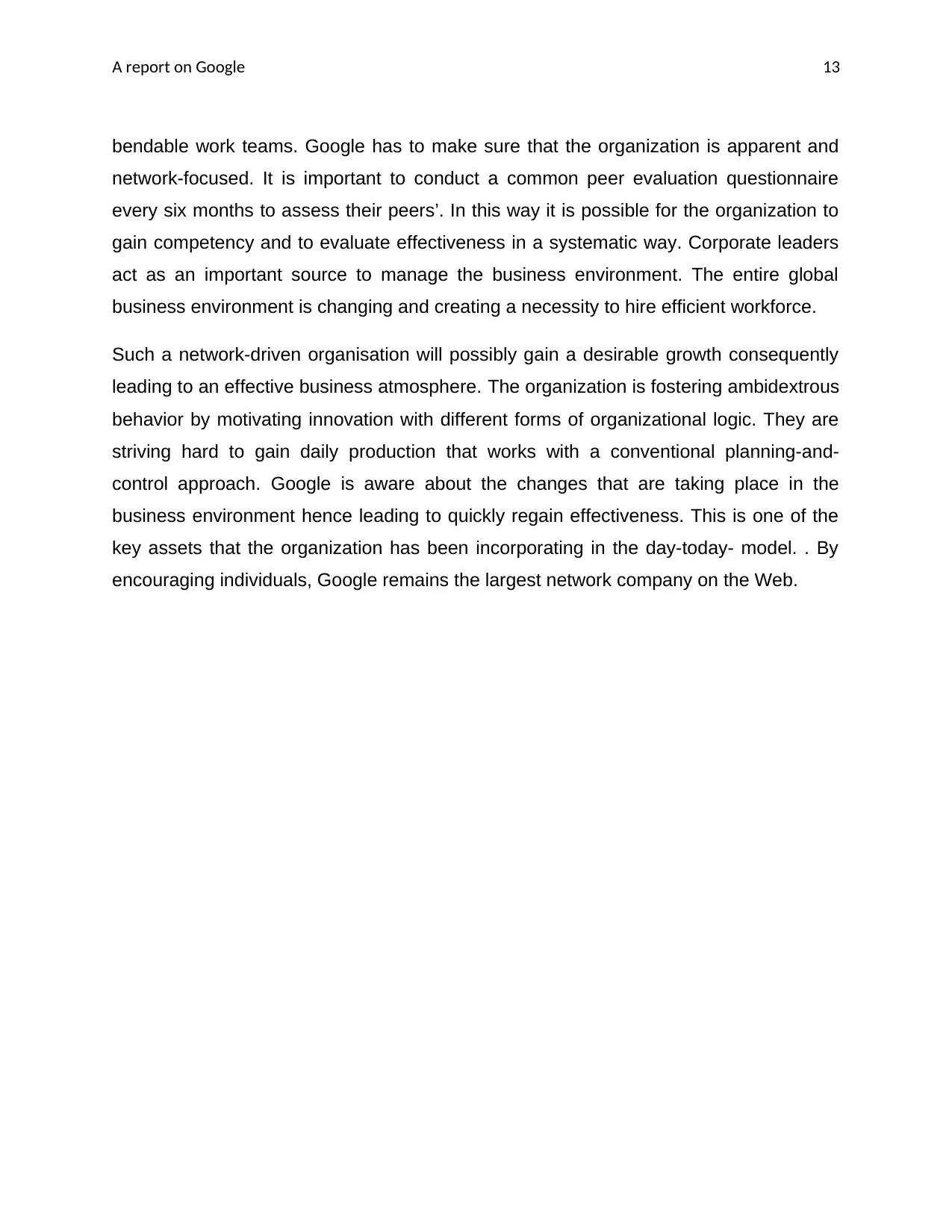
A report on Google 13
bendable work teams. Google has to make sure that the organization is apparent and
network-focused. It is important to conduct a common peer evaluation questionnaire
every six months to assess their peers’. In this way it is possible for the organization to
gain competency and to evaluate effectiveness in a systematic way. Corporate leaders
act as an important source to manage the business environment. The entire global
business environment is changing and creating a necessity to hire efficient workforce.
Such a network-driven organisation will possibly gain a desirable growth consequently
leading to an effective business atmosphere. The organization is fostering ambidextrous
behavior by motivating innovation with different forms of organizational logic. They are
striving hard to gain daily production that works with a conventional planning-and-
control approach. Google is aware about the changes that are taking place in the
business environment hence leading to quickly regain effectiveness. This is one of the
key assets that the organization has been incorporating in the day-today- model. . By
encouraging individuals, Google remains the largest network company on the Web.
bendable work teams. Google has to make sure that the organization is apparent and
network-focused. It is important to conduct a common peer evaluation questionnaire
every six months to assess their peers’. In this way it is possible for the organization to
gain competency and to evaluate effectiveness in a systematic way. Corporate leaders
act as an important source to manage the business environment. The entire global
business environment is changing and creating a necessity to hire efficient workforce.
Such a network-driven organisation will possibly gain a desirable growth consequently
leading to an effective business atmosphere. The organization is fostering ambidextrous
behavior by motivating innovation with different forms of organizational logic. They are
striving hard to gain daily production that works with a conventional planning-and-
control approach. Google is aware about the changes that are taking place in the
business environment hence leading to quickly regain effectiveness. This is one of the
key assets that the organization has been incorporating in the day-today- model. . By
encouraging individuals, Google remains the largest network company on the Web.
Paraphrase This Document
Need a fresh take? Get an instant paraphrase of this document with our AI Paraphraser
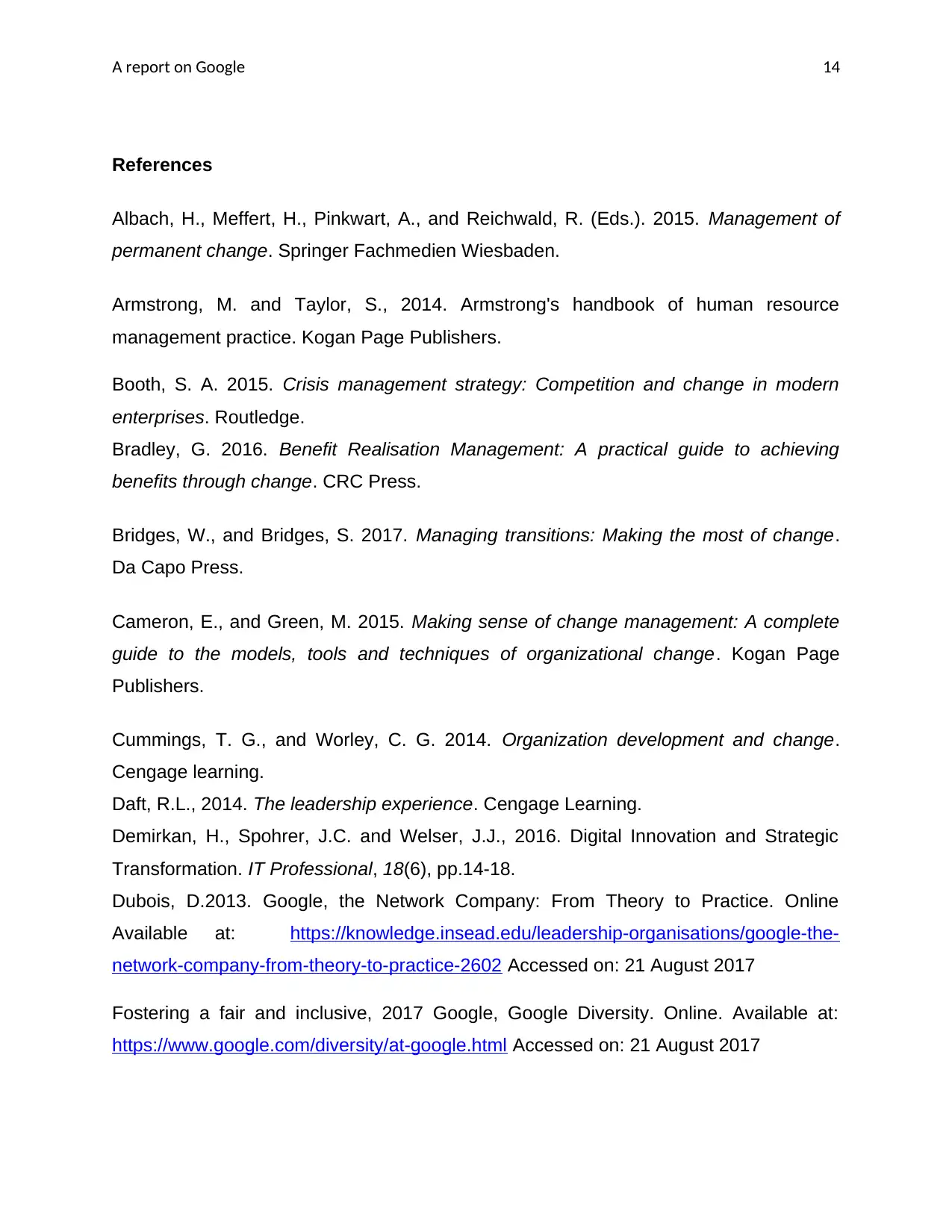
A report on Google 14
References
Albach, H., Meffert, H., Pinkwart, A., and Reichwald, R. (Eds.). 2015. Management of
permanent change. Springer Fachmedien Wiesbaden.
Armstrong, M. and Taylor, S., 2014. Armstrong's handbook of human resource
management practice. Kogan Page Publishers.
Booth, S. A. 2015. Crisis management strategy: Competition and change in modern
enterprises. Routledge.
Bradley, G. 2016. Benefit Realisation Management: A practical guide to achieving
benefits through change. CRC Press.
Bridges, W., and Bridges, S. 2017. Managing transitions: Making the most of change.
Da Capo Press.
Cameron, E., and Green, M. 2015. Making sense of change management: A complete
guide to the models, tools and techniques of organizational change. Kogan Page
Publishers.
Cummings, T. G., and Worley, C. G. 2014. Organization development and change.
Cengage learning.
Daft, R.L., 2014. The leadership experience. Cengage Learning.
Demirkan, H., Spohrer, J.C. and Welser, J.J., 2016. Digital Innovation and Strategic
Transformation. IT Professional, 18(6), pp.14-18.
Dubois, D.2013. Google, the Network Company: From Theory to Practice. Online
Available at: https://knowledge.insead.edu/leadership-organisations/google-the-
network-company-from-theory-to-practice-2602 Accessed on: 21 August 2017
Fostering a fair and inclusive, 2017 Google, Google Diversity. Online. Available at:
https://www.google.com/diversity/at-google.html Accessed on: 21 August 2017
References
Albach, H., Meffert, H., Pinkwart, A., and Reichwald, R. (Eds.). 2015. Management of
permanent change. Springer Fachmedien Wiesbaden.
Armstrong, M. and Taylor, S., 2014. Armstrong's handbook of human resource
management practice. Kogan Page Publishers.
Booth, S. A. 2015. Crisis management strategy: Competition and change in modern
enterprises. Routledge.
Bradley, G. 2016. Benefit Realisation Management: A practical guide to achieving
benefits through change. CRC Press.
Bridges, W., and Bridges, S. 2017. Managing transitions: Making the most of change.
Da Capo Press.
Cameron, E., and Green, M. 2015. Making sense of change management: A complete
guide to the models, tools and techniques of organizational change. Kogan Page
Publishers.
Cummings, T. G., and Worley, C. G. 2014. Organization development and change.
Cengage learning.
Daft, R.L., 2014. The leadership experience. Cengage Learning.
Demirkan, H., Spohrer, J.C. and Welser, J.J., 2016. Digital Innovation and Strategic
Transformation. IT Professional, 18(6), pp.14-18.
Dubois, D.2013. Google, the Network Company: From Theory to Practice. Online
Available at: https://knowledge.insead.edu/leadership-organisations/google-the-
network-company-from-theory-to-practice-2602 Accessed on: 21 August 2017
Fostering a fair and inclusive, 2017 Google, Google Diversity. Online. Available at:
https://www.google.com/diversity/at-google.html Accessed on: 21 August 2017
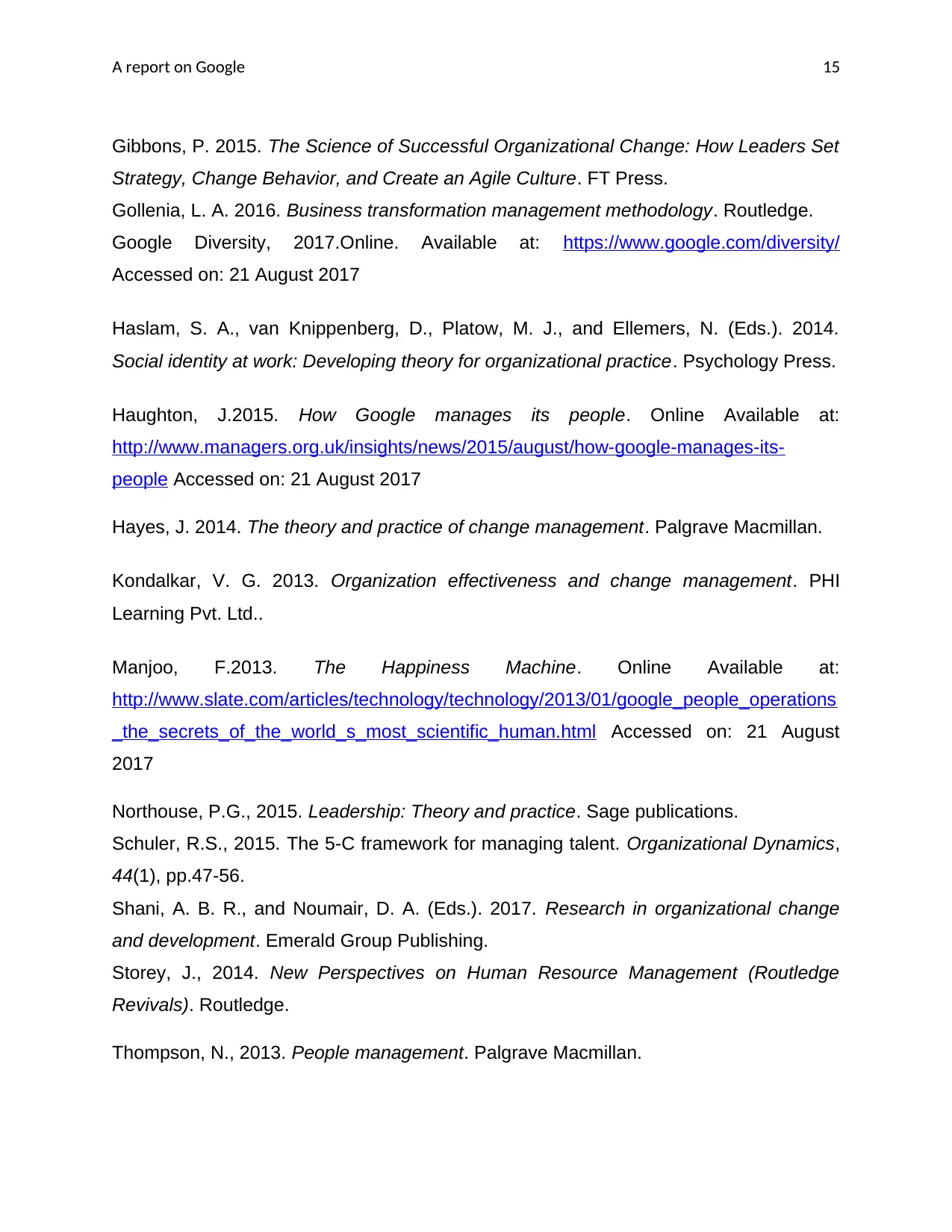
A report on Google 15
Gibbons, P. 2015. The Science of Successful Organizational Change: How Leaders Set
Strategy, Change Behavior, and Create an Agile Culture. FT Press.
Gollenia, L. A. 2016. Business transformation management methodology. Routledge.
Google Diversity, 2017.Online. Available at: https://www.google.com/diversity/
Accessed on: 21 August 2017
Haslam, S. A., van Knippenberg, D., Platow, M. J., and Ellemers, N. (Eds.). 2014.
Social identity at work: Developing theory for organizational practice. Psychology Press.
Haughton, J.2015. How Google manages its people. Online Available at:
http://www.managers.org.uk/insights/news/2015/august/how-google-manages-its-
people Accessed on: 21 August 2017
Hayes, J. 2014. The theory and practice of change management. Palgrave Macmillan.
Kondalkar, V. G. 2013. Organization effectiveness and change management. PHI
Learning Pvt. Ltd..
Manjoo, F.2013. The Happiness Machine. Online Available at:
http://www.slate.com/articles/technology/technology/2013/01/google_people_operations
_the_secrets_of_the_world_s_most_scientific_human.html Accessed on: 21 August
2017
Northouse, P.G., 2015. Leadership: Theory and practice. Sage publications.
Schuler, R.S., 2015. The 5-C framework for managing talent. Organizational Dynamics,
44(1), pp.47-56.
Shani, A. B. R., and Noumair, D. A. (Eds.). 2017. Research in organizational change
and development. Emerald Group Publishing.
Storey, J., 2014. New Perspectives on Human Resource Management (Routledge
Revivals). Routledge.
Thompson, N., 2013. People management. Palgrave Macmillan.
Gibbons, P. 2015. The Science of Successful Organizational Change: How Leaders Set
Strategy, Change Behavior, and Create an Agile Culture. FT Press.
Gollenia, L. A. 2016. Business transformation management methodology. Routledge.
Google Diversity, 2017.Online. Available at: https://www.google.com/diversity/
Accessed on: 21 August 2017
Haslam, S. A., van Knippenberg, D., Platow, M. J., and Ellemers, N. (Eds.). 2014.
Social identity at work: Developing theory for organizational practice. Psychology Press.
Haughton, J.2015. How Google manages its people. Online Available at:
http://www.managers.org.uk/insights/news/2015/august/how-google-manages-its-
people Accessed on: 21 August 2017
Hayes, J. 2014. The theory and practice of change management. Palgrave Macmillan.
Kondalkar, V. G. 2013. Organization effectiveness and change management. PHI
Learning Pvt. Ltd..
Manjoo, F.2013. The Happiness Machine. Online Available at:
http://www.slate.com/articles/technology/technology/2013/01/google_people_operations
_the_secrets_of_the_world_s_most_scientific_human.html Accessed on: 21 August
2017
Northouse, P.G., 2015. Leadership: Theory and practice. Sage publications.
Schuler, R.S., 2015. The 5-C framework for managing talent. Organizational Dynamics,
44(1), pp.47-56.
Shani, A. B. R., and Noumair, D. A. (Eds.). 2017. Research in organizational change
and development. Emerald Group Publishing.
Storey, J., 2014. New Perspectives on Human Resource Management (Routledge
Revivals). Routledge.
Thompson, N., 2013. People management. Palgrave Macmillan.
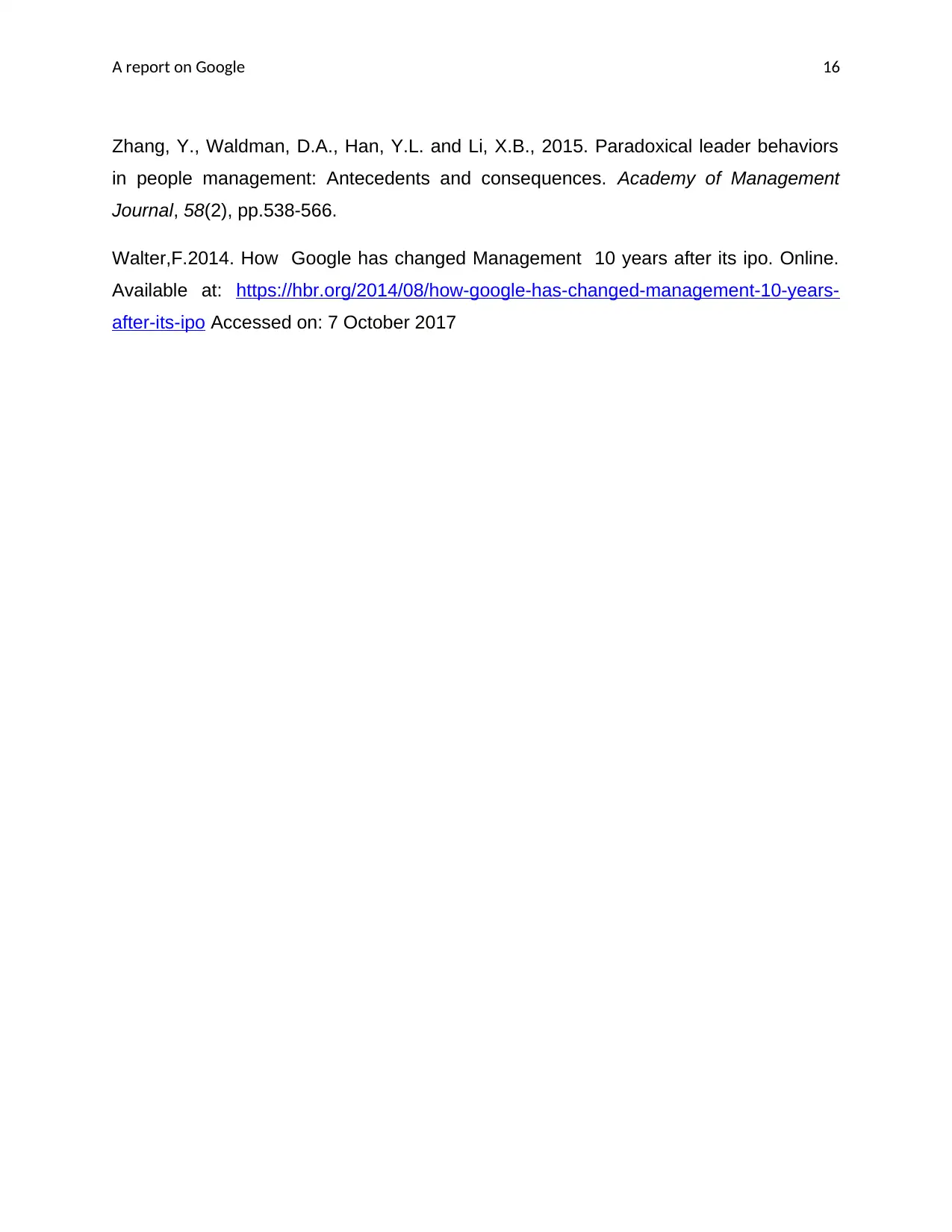
A report on Google 16
Zhang, Y., Waldman, D.A., Han, Y.L. and Li, X.B., 2015. Paradoxical leader behaviors
in people management: Antecedents and consequences. Academy of Management
Journal, 58(2), pp.538-566.
Walter,F.2014. How Google has changed Management 10 years after its ipo. Online.
Available at: https://hbr.org/2014/08/how-google-has-changed-management-10-years-
after-its-ipo Accessed on: 7 October 2017
Zhang, Y., Waldman, D.A., Han, Y.L. and Li, X.B., 2015. Paradoxical leader behaviors
in people management: Antecedents and consequences. Academy of Management
Journal, 58(2), pp.538-566.
Walter,F.2014. How Google has changed Management 10 years after its ipo. Online.
Available at: https://hbr.org/2014/08/how-google-has-changed-management-10-years-
after-its-ipo Accessed on: 7 October 2017
1 out of 16
Related Documents
Your All-in-One AI-Powered Toolkit for Academic Success.
+13062052269
info@desklib.com
Available 24*7 on WhatsApp / Email
![[object Object]](/_next/static/media/star-bottom.7253800d.svg)
Unlock your academic potential
© 2024 | Zucol Services PVT LTD | All rights reserved.





